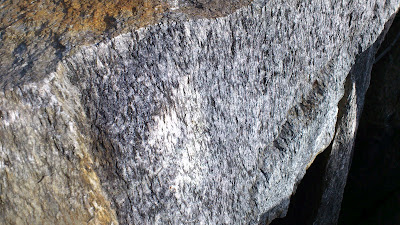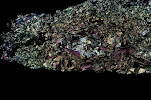I have always been a visual person, and one of my favourite parts about being a petrologist is the pretty photos of thin sections that I have collected. I also love organizing stuff—I was one of those kids who had even more fun sorting my legos by colour, size, and type than I did actually building things out of them. However, until this week, it had never occurred to me that it would be possible to do visual organization of my photos. Oh, sure, I had some organization of my sample photos—a folder for all the thin section photos, and sub folders for each sample. Another folder for photos of drill cores, with sub folders for each drill hole, and under those more sub folders for each box of core (since when using my phone I need to take nine photos per tray of core in order to photograph every bit of it.
But that was where my organizational system stopped. If I wanted to do something like, gather together all of the rhyolite samples and look to see if they were similar or different to one another I would open the spreadsheet of samples, sort by rock type, then, one sample at a time go through the folder of photos for each sample, import it into my drawing program, add text, insert a new page for the next sample, repeat.
Then I read a blog post by my favourite medieval textile scholar describing the photo organizational database she uses. She mentioned that one can store photos in a folder yet, at the same time, have “albums” to organize them, and the possibility of one photo belonging to more than one album, without duplicating the photo. Her description of being able to define smart albums based on key words associated with the photos caught my attention, so I went off and got a copy of the program.
Doing this has really re-inspired me to work. My partner and I recently bought a house, and a rather large part of me had been resenting “work” as something that was interfering with important things like getting the house unpacked and organized, and exploring the forest outside of our door. But now I am keen to come into the office and play with my photos and organize them. I am actually looking forward to writing papers, because choosing the right image to show the feature I describe in the text will be so easy with this tool.
So far I have created albums for each drill hole, and sub albums within the drill holes for the individual samples. I have copied all of the notes I took for each sample into the album description, so I can see at a glance which phases are present, what rock type I assigned the sample to, where the sample comes from, and so much more. I am adding key words to my samples so that I can later ask to see all photos containing feldspar, or pyrite, or whatever, and I will get them. The program lets one select multiple photos at once and apply key words to them all at one go, which saves time.
One bit of advice if you decide to do something like this: Decide on your key word pattern as early as possible. My photos are marked with a variety of types of key words, and my first attempt I just typed in useful words like “PPl”, “XPL”, “folded” “Qtz”, “10X” etc. But then I realized that one can add key words from a drop-down menu, which is sorted alphabetically. After I made that realization I added a type code to the front of the key words, and now I can specify if the key word is a “drill hole”, the “scale”, a mineral (“min”), a phase that only shows up in this sample as inclusions within another mineral (“inc”), the rock type, structure, or any number of other categories that I will come up with later. This makes choosing the keywords much easier, as they are now grouped together, so I can click on the one I need.























